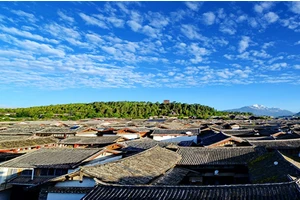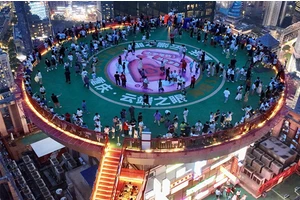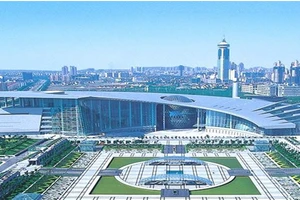Military reclamation tourism
In the early summer, I was lucky enough to visit the hometown of Xinjiang Production and Construction Corps, the "First Company of Army Reclamation". The wooden plow, the dry hitting of the base, and a series of objects in the pit strongly hit the heart and lingered for a long time.
The first company of military reclamation is located at the northern foot of Hongshan Mountain on the west bank of Manas River in Shihezi, Xinjiang. It used to be the place where the reclamation company was stationed in the 1950s. Now, it preserves the military reclamation relics such as the Diwozi Group, the dry-base kitchen, the water storage dam and other reclamation tools and daily necessities. It is a military reclamation education tourist attraction built by the 152nd Regiment of the Eighth Agricultural Division of Xinjiang Production and Construction Corps in 2002 with an investment of more than 3 million yuan.
The clouds of history have not yet receded.
In November, 1949, General Wang Zhen led troops to Xinjiang, and Xinjiang was peacefully liberated. The officers and men reclaimed land on the spot to suppress bandits. In October 1954, the Central Committee set up the "China People's Xinjiang Military Region Production and Construction Corps", and 100,000 troops started a large-scale conversion to land reclamation. The "First Company of Army Reclamation" was the defense station of 7th Company, 3rd Battalion, 26th Division, 77th Regiment, 9th Army of China People's Corps. At that time, more than 170 people were ordered to dig out nests, build dry foundations, dig waterlogged dams and open up wasteland to form a residential area integrating defense and production.
The "First Company of Army Reclamation" is backed by Hongshan Mountains and surrounded by Gobi Desert. The gate of the scenic spot is an antique giant wooden plow sculpture. On the left, there is an old-fashioned sentry box with a quadrangle spire, and on the right, there are two statues of "Army Reclamation" with "Kantuman" on their backs. The company's shack with adobe earth walls displays the tools of production in that year: wooden plows, hoes, rakes, stone mills, dustpans, spinning wheels, looms and other daily necessities. Outdoor reproduction of guns and car ordnance left in that year. The two slogans tell a sad and high-spirited story: "Wild green onions, clear water soup, and three meals are the same. It's hard to swallow and eat, or you'll be hungry at work. " "A knot in one's heart potato corn grits, dry base burning cow dung. Wrap a rotten sheepskin on your feet and patrol the border with a rifle. "
Dry-laying is a simple house built by using local materials and building walls with soil or plates. In fact, it is a plywood-walled house in the mainland. However, the roof here is covered with sticks and grass, not to mention leakage prevention. It seldom rains here, but the function of keeping warm and avoiding summer heat can't be worse.
Most of the "ground nests" dug underground are three meters deep. Stepping into it, a cold and humid mildew came to my face, and only a ray of light shone from the roof skylight where the grass was muddy. The bed is covered with dirt, and the lighting is kerosene lamp or lantern made of glass bottles. The better condition is a simple wooden bed, but it is a public wedding room, and only whose wives come to visit relatives can enjoy such treatment.
The wall of the company headquarters is covered with photos of the company's reclamation, study and military training life in various periods. There is a saying that "eight people pull a plow to piss off cows", saying that eight people used a plow to reclaim 10 acres a day. There is also a photo of "the story of begging for a wife", saying that Wang Zhen went to a unit for a meeting and asked everyone if they had any opinions after speaking. A foolish soldier stood up and said, "Report to the chief, I have an opinion. We don't have a wife yet, so you have to solve our wife's problem. " Provoked everyone to burst into laughter. Wang Zhen later reported to the CPC Central Committee, mobilized a large number of mainland young women to aid Xinjiang, and solved the marriage problems of a large number of commanders and soldiers.
Strolling in the past scene of the "First Company of Army Reclamation", I am full of thoughts. More than 100 people in this company reclaimed hundreds of acres and dug three waterlogged dams to solve the water problem. At that time, the place was deserted and mosquitoes were flying everywhere. The soldiers covered their heads with gauze to prevent mosquito bites, and they looked like beekeepers wearing masks. However, mosquitoes are small, and they are always hard to prevent. Later, they learned to "make up" and put thin mud on their bodies before going to work every day. Be a vivid "black clay figurine". What spirit is this? What did they leave their homes for? Reputation Money? Neither! That is the selfless dedication of loving the motherland and the people!
According to relevant data, today's Xinjiang Production and Construction Corps has more than 2.7 million people guarding the border line for more than 2,000 kilometers, covering a land area of more than 70,000 square kilometers and reclaiming millions of hectares of cultivated land. How many "Army Reclamation Company" have fought in this hot land for decades? How much food and materials are produced to support national construction? The Gobi desert, which used to be uninhabited, has now become an oasis, and how many army reclamation people have irrigated this land with their blood and sweat? How many sleepless nights have people on the border survived?
Tianshan mountain has feelings, and the sun and the moon witness it!
[Editor's Note]: The history of the Xinjiang Production and Construction Corps' "First Company of Army Reclamation" has been reopened. The struggle scene of that year seems like yesterday. Without some cold and bitterness, there is no Tianshan posture today. The years worthy of nostalgia are worthy of inheriting the spirit of military reclamation. The article takes us into the army reclamation in Xinjiang to learn about the hot years.
Recommended tourist attractions in Shihezi:
1. Army Reclamation in Western Regions
The military reclamation in the Western Regions is located at the northern foot of Hongshan Mountain on the west bank of Manas River in Shihezi. It was originally the headquarters of the reclamation company in the 1950s, and preserved the relics of the military reclamation, such as the Diwozi group, the dry-base kitchen, the water storage dam, and other reclamation tools and daily necessities.
2. Guanyin Mountain in Shihezi
Guanyin Mountain in Shihezi is about 70 kilometers north of Shihezi City, belonging to Ziniquan Sheep Breeding Farm of the 151st Regiment of the Eighth Agricultural Division. It was once famous for cultivating the famous "China Merino Army Reclamation Type" sheep.
This grassland is the crisscross area of mountain forest belt and mountain meadow grassland belt. In the south, there is the Yilian Habigar Mountain in Tianshan Mountain, and at the foot of it, there is a magnificent Manas River Gorge, with an altitude of 1,500-2,400 meters. Every early spring, lush alpine alkali grass and undulating Hongshan structure are red and green, and they are colorful. It is a paradise for rock climbers and donkey friends.
3. Shihezi Nanshan Scenic Area
Shihezi Nanshan Scenic Area is located about 80 kilometers south of Shihezi, with steep mountains, valleys, beautiful peaks and towering trees. It is a tourist attraction in Shihezi. There are more than 100 kinds of wild Chinese herbal medicines such as Angelica sinensis, Rehmannia glutinosa, Fritillaria, etc. There are dozens of wild animals such as Tianshan Red Deer, capra ibex, Brown Bear, Wild Boar, Marmot, Snow Chicken, Golden Eagle, Snow Leopard, etc. Nanshan Scenic Area is a fascinating tourist attraction with endless myths.
4. Mahe Grand Canyon
Mahe Grand Canyon is the upper reaches of Manas River. Mahe Grand Canyon twists and turns, with steep slopes on both sides of the valley, green river gurgling in the valley, and dozens of kilometers of valleys are surrounded by green Achnatherum splendens, red, gray and yellow valleys, wide riverbeds, rich and colorful vegetation, and grass leaves floating on the water, forming a trace of life with Huangshan Mountain and low gorge beside the pond.
5. Shihezi People's Park
Shihezi People's Park is located in the southwest corner of the intersection of Beisan Road and Xiyi Road, covering an area of more than 1,500 mu. Construction began in the mid-1950s, with a forest area and a tourist area. The south of the park is a forest area, where dozens of trees, such as Pinus sylvestris var. mongolica, Picea koraiensis and Juniper juniper, have settled down, and hundreds of trees have grown unexpectedly, accounting for two-thirds of the park area.






